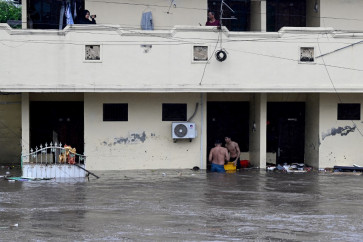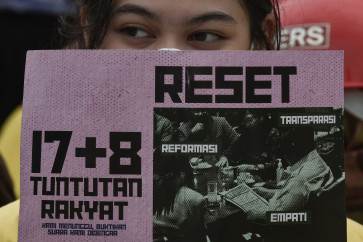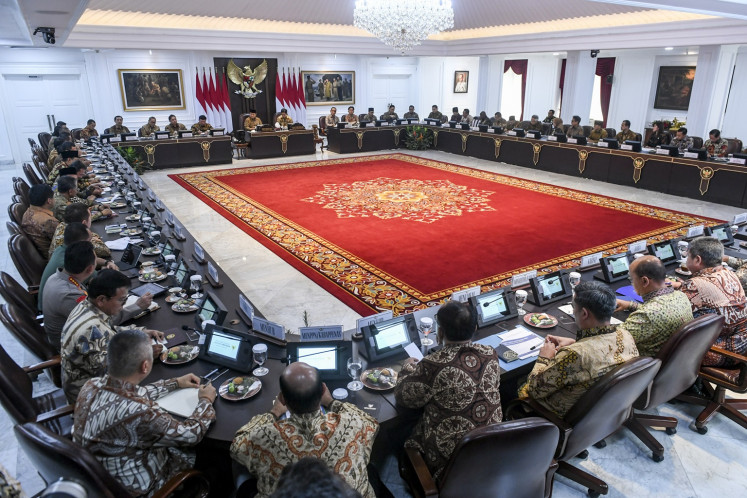Popular Reads
Top Results
Can't find what you're looking for?
View all search resultsPopular Reads
Top Results
Can't find what you're looking for?
View all search resultsMedical care still a problem in handling HIV/AIDS in RI
Stop AIDS: An activist takes part in a rally that seeks to promote public awareness on HIV/AIDS on Dec
Change text size
Gift Premium Articles
to Anyone
S
top AIDS: An activist takes part in a rally that seeks to promote public awareness on HIV/AIDS on Dec. 1 in Jakarta. (JP/Arief Suhardiman)
Scientists have raced to find a way to treat — if not cure — HIV since the early days of the AIDS epidemic in the 1980s.
The World Health Organization has estimated that 75 million people have been infected with HIV and 32 million people have died of HIV/AIDS-related complications around the world since the beginning of the epidemic. It reports that approximately 37.9 million people were living with HIV in 2018.
The Centers for Disease Control and Prevention (CDC) identified the first outbreak of AIDS in the United States in 1981, and in 1983, an international committee of scientific researchers identified its cause, the HIV.
The first HIV case in Indonesia was reported in 1986.
The virus, however, is believed to have developed decades earlier in the early 20th century, and was first transmitted from a West African chimpanzee species to humans.
HIV weakens the human immune system by specifically attacking the white blood cells called CD4 helper cells (also T cells) that fight infection.
As HIV destroys the T cells in our body, we become unable to fight infection and disease, which then leaves us vulnerable to opportunistic infections. People infected with HIV have a heightened risk of developing certain cancers and life-threatening infections, including tuberculosis and pneumonia.
Left untreated, people infected with HIV develop a condition called AIDS in about 10 years. AIDS is not a disease, and according to the WHO, refers to an advanced stage of HIV infection at which the immune system is severely damaged and can no longer fight infection or disease.
HIV is spread from person to person through bodily fluids, including blood, breast milk, semen, vaginal fluids and anal fluids. The virus is transmitted primarily through unprotected sex, needle sharing and mother-to-child transmission.
Researchers have yet to find a cure for HIV/AIDS, but early diagnosis and treatment can prolong the lives of HIV-infected patients to normal life expectancy. In the first few years of the epidemic, HIV-infected patients who had developed AIDS faced certain death. But medical advances over the decades have provided a means for patients to manage their HIV levels and avoid developing AIDS.
The first HIV treatment in the US was azidothymidine (AZT), which became available in the late 1980s. Since then, researchers have created numerous other medicines that block specific stages in the life cycle of HIV — antiretroviral (ARV) drugs.
The combination of these medications is known as antiretroviral therapy (ART), which works to prevent HIV from replicating and suppress the amount of the virus in our body, thereby halting its progression to give our immune system an opportunity to recover. ART can also reduce the risk of mother-to-child transmission during pregnancy, childbirth and breastfeeding.
The chairman of the HIV/AIDS Expert Panel’s Patient Information Management System, Dr. Samsuridjal Djauzi, told CNBC Indonesia that ART had reduced HIV/AIDS mortality in Indonesia since its arrival in 2014. Before ART was made available, the life expectancy for people with AIDS was between six months and two years.
HIV-infected patients must take ARV drugs every day to keep their HIV levels under control. Tirto.com reports that the medication is available in Indonesia for Rp 385,000 (US$27.29) to Rp 400,000.
Indonesia still has room to improve its ART coverage, as many people living with HIV/AIDS (PLWHA) still do not receive appropriate medical care. According to the latest Health Ministry data, approximately 115,750 PLWHA were receiving antiretroviral treatment, whereas the ministry’s 2018 reported that 301,959 people had been diagnosed as HIV-positive in Indonesia.
Among the areas that need improvement for better distribution and coverage of ART are political will, the test-and-treat approach for screening and early treatment of HIV/AIDS, speedier adoption of the latest HIV/AIDS recommendations from other countries, and addressing and eliminating social stigma and discrimination against PLWHA.










